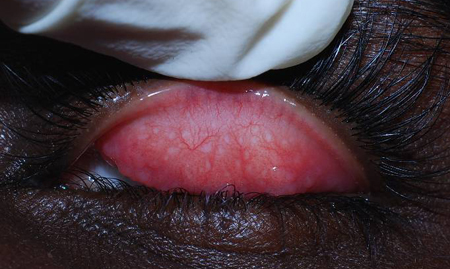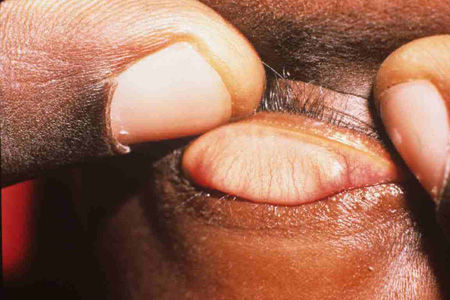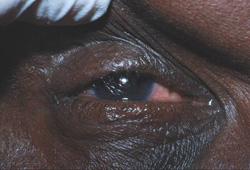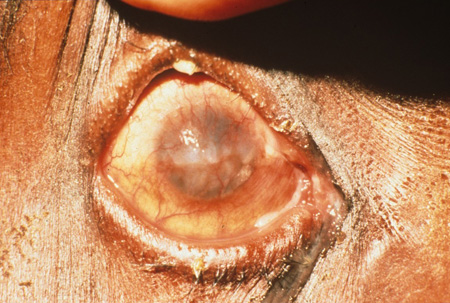Etiology
Trachoma is a keratoconjunctivitis caused by ocular infection with Chlamydia trachomatis (serovars A, B, Ba, and C).
Pathophysiology
A single episode of infection with the obligate intracellular gram-negative bacterium Chlamydia trachomatis (serovars A, B, Ba, and C) causes a self-limiting conjunctivitis, which can be acute or silent. The disease is spread by contact with ocular and nasal secretions. Flies are a putative vector.
Children who are repeatedly infected develop a typical follicular inflammatory response of the tarsal conjunctiva. It is this typical pathologic response that characterizes active trachoma and over time may lead to pathologic scarring. Repeated episodes of intense conjunctival inflammation seem to be the most important predictor of subsequent morbidity.[5] Progressive scarring of the conjunctiva alters the architecture of the eyelid, thereby pulling the eyelid margin inward and causing lashes to rub on the globe (trichiasis). The constant abrasive effect of the lashes on the corneal surface, if left untreated, will rapidly induce scarring and subsequent corneal opacification, leading to irreversible vision loss.[Figure caption and citation for the preceding image starts]: Eyelid eversion demonstrating follicles on the upper tarsal conjunctivaFrom the collection of Dr Hugh R. Taylor [Citation ends]. [Figure caption and citation for the preceding image starts]: A normal eyelidFrom the collection of Dr Hugh R. Taylor [Citation ends].
[Figure caption and citation for the preceding image starts]: A normal eyelidFrom the collection of Dr Hugh R. Taylor [Citation ends]. [Figure caption and citation for the preceding image starts]: Eyelid eversion demonstrating scars on the tarsal conjunctivaFrom the collection of Dr Hugh R. Taylor [Citation ends].
[Figure caption and citation for the preceding image starts]: Eyelid eversion demonstrating scars on the tarsal conjunctivaFrom the collection of Dr Hugh R. Taylor [Citation ends]. [Figure caption and citation for the preceding image starts]: A red eye due to at least 1 inturned eyelash touching the globe (trachomatous trichiasis)From the collection of Dr Hugh R. Taylor [Citation ends].
[Figure caption and citation for the preceding image starts]: A red eye due to at least 1 inturned eyelash touching the globe (trachomatous trichiasis)From the collection of Dr Hugh R. Taylor [Citation ends]. [Figure caption and citation for the preceding image starts]: Corneal opacity due to trachomaFrom the collection of Dr Hugh R. Taylor [Citation ends].
[Figure caption and citation for the preceding image starts]: Corneal opacity due to trachomaFrom the collection of Dr Hugh R. Taylor [Citation ends].
When a cohort of individuals with trachomatous scarring was followed over 12 years in a hypo-endemic environment, 6% were found to have developed trichiasis, and 3% had corneal visual impairment.[6] Presentation of scarring and disease progression will be much faster in areas of high prevalence.[7] There are few longitudinal studies that provide estimates of trachoma progression rate.[8]
Classification
Classification according to stage of disease
Active trachoma: an inflammatory reaction to infection with Chlamydia trachomatis, seen predominantly in children.
Cicatricial disease: the late stage of the disease, typically characterized by scarring of the tarsal conjunctiva and alterations to lid morphology that can lead to trachomatous trichiasis and entropion. Trachomatous trichiasis can present in the absence of patent scarring, entropion, or signs of active trachoma.
Use of this content is subject to our disclaimer